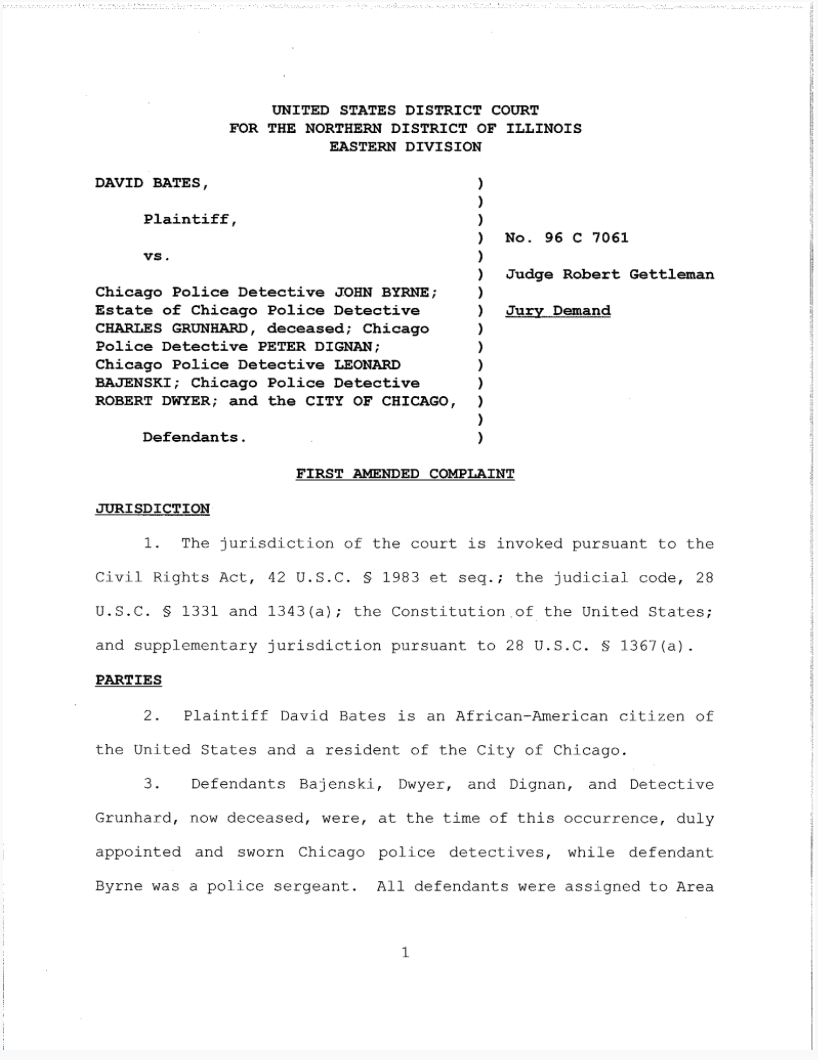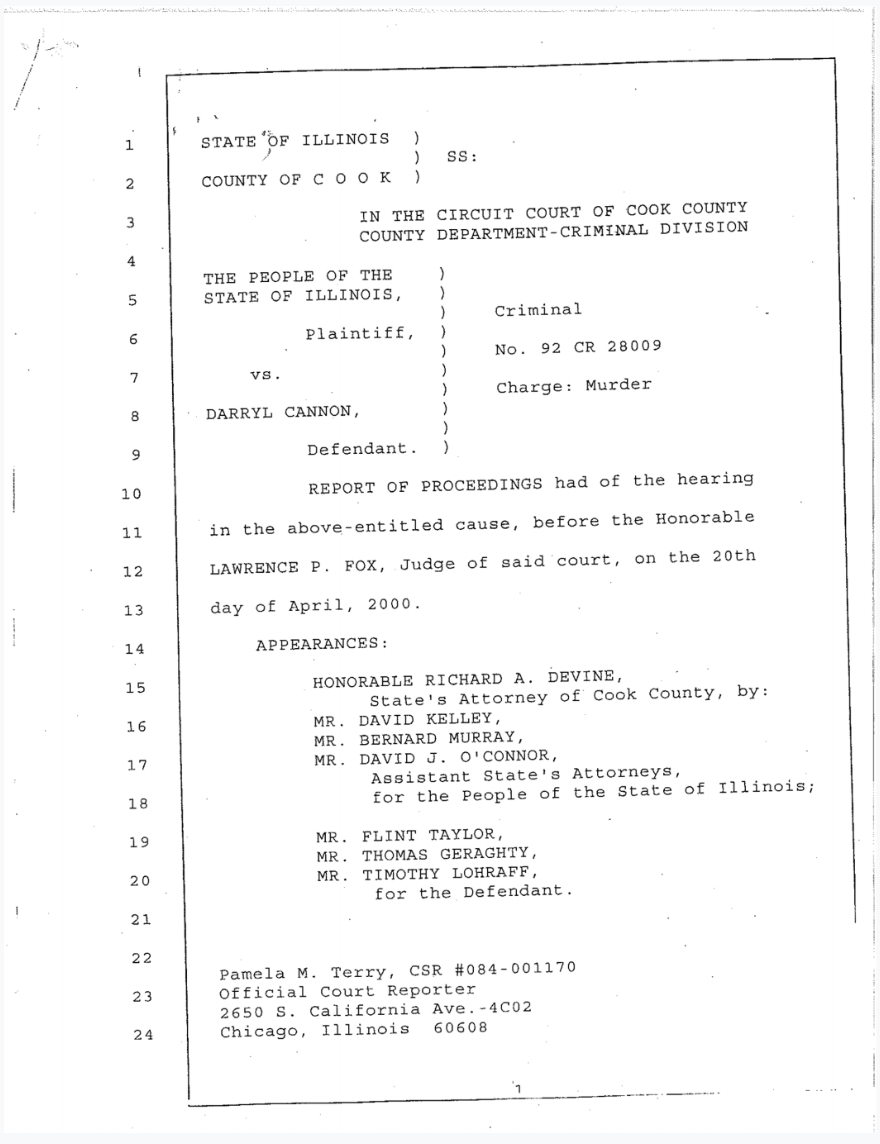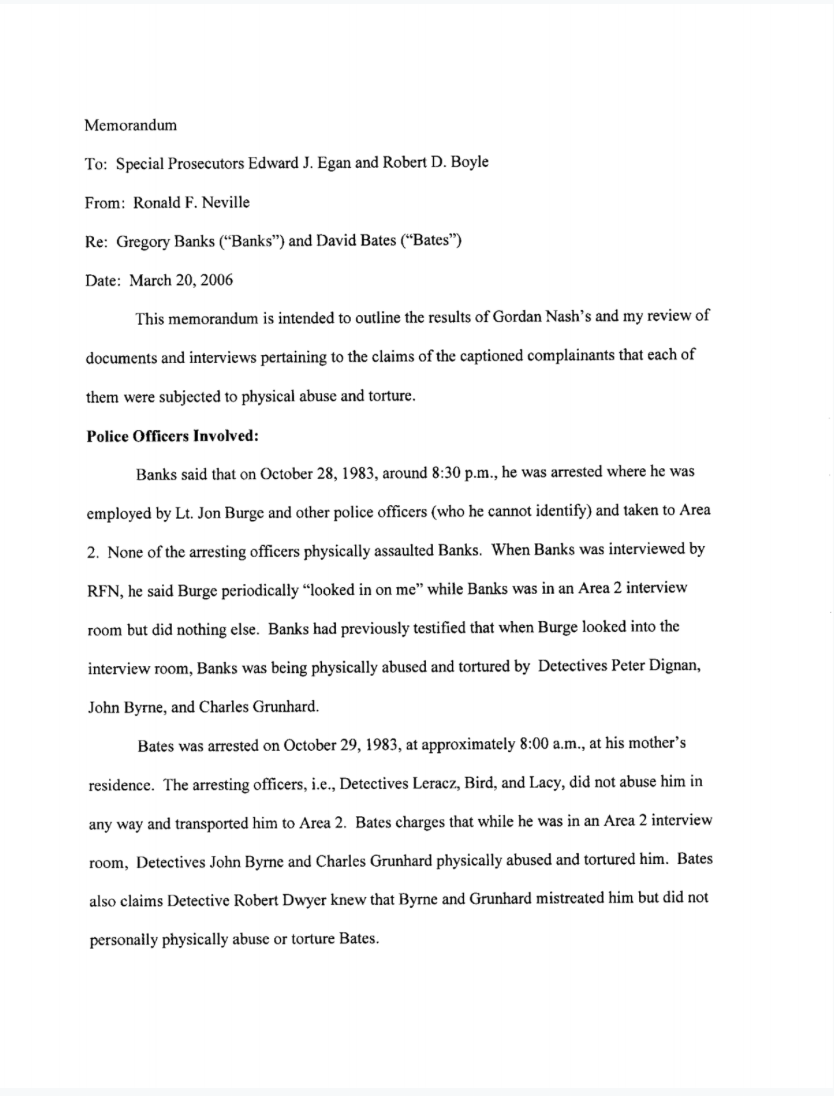On October 27, 1983, two men opened fire with handguns in what police said was a drug deal involving cough syrup and codeine that went bad on Chicago’s South Side. Leon Barkan was killed and 24-year-old Jeltro Givens was wounded.
On the night of October 28, detectives working under the command of Lt. Jon Burge brought in 20-year-old Gregory Banks for questioning because a witness implicated Banks in the shooting.
Banks later testified that Detective Peter Dignan took him to an interview room at the police station and, accompanied by Detectives John Byrne and Charles Grunhard, demanded that Banks confess. When Banks denied involvement, Byrne put the barrel of a .45 semi-automatic pistol in Banks’s mouth and said, “I should blow your head off because you know what we are talking about.” Dignan then struck him several times with a flashlight and Grunhard kicked him repeatedly.
Banks and Bates tortured
When Banks continued to deny wrongdoing, they knocked him to the floor. Dignan said, “We have something for niggers.” He then sat on top of him and put a plastic bag over Banks’s head and pulled it tight to cut off his air supply. Grunhard then kicked Banks several times in the side and abdomen. They then removed the bag and left the room.
The detectives returned about 15 minutes later and Dignan again put the bag over Banks’s head and tightened it. When Banks began having difficulty breathing, they removed the bag. At that point, Banks, fearing for his life, confessed to firing the gunshots. He also implicated a friend, 18-year-old David Bates, in the shooting, saying Bates acted as a lookout.
Bates was arrested at 8 a.m. on October 29, 1983 at his home and taken to the police station where Byrne and Grunhard questioned him. When Bates denied any knowledge of the crime, the detectives punched him repeatedly. Byrne and Grunhard then put a plastic bag over Bates’s head, cinched it tight, and then one of the officers punched Bates in the abdomen.
When Bates continued to protest he was innocent, the officers left the room. But they later returned and over the next several hours, Bates later testified, he was kicked in the testicles, punched repeatedly, and nearly suffocated with the plastic bag three more times. Finally, Bates, fearing he would be killed, gave a confession.
Bates and Banks would later discover they were among more than 100 young Black men who were similarly tortured by Burge and his detectives during the 1970s and 1980s. Besides the use of plastic bag near-suffocation, the torture included kicking, punching, choking, threats to execute suspects with pistols and shotguns, and administering electrical shocks with a hand-cranked generator.
Banks and Bates were charged with first-degree murder, armed robbery, and attempted murder.
Prior to trial, Banks and Bates filed a motion to bar the use of their confessions at trial because the statements were false and coerced by the physical abuse at the hands of the detectives. The detectives denied the use of a plastic bag and other abuse. Although Dignan conceded that he struck Banks a few times, he said that occurred when Banks tried to escape. Dignan said the officers took Banks to a building, where he pointed out a gun, some cough syrup, and codeine on the roof of the second floor. Dignan testified that on their way down a flight of stairs, Banks tried to escape, and that he tackled and punched Banks during a struggle to subdue him.
The defense presented medical testimony that Banks’ injuries were consistent with being beaten with a blunt object—not rolling down a flight of stairs.
Separate trials for Banks, Bates
The motion to suppress the confessions was denied and in September 1985, Bates and Banks went to trial simultaneously in Cook County Circuit Court. A jury was selected to decide Banks’s case and Bates chose to have the trial judge decide his case.
Jeltro Givens, who was wounded in the shooting, testified that he and Barkan left a home with a gallon of cough syrup and codeine—which, when consumed together, creates a high—and were ambushed by two men wearing ski masks. Givens said he ran across the street. From there, he said he saw one of the men fire three shots at Barkan. Givens heard bullets ricochet off the sidewalk, and then Barkan fell down. Givens testified that he was shot in the thigh as he ran. He saw the second man grab the bag and both men then fled. Givens could not identify the two men.
Banks testified that while he was at work on the day Barkan was killed, Barkan telephoned and asked to meet him. Banks said he agreed to meet Barkan outside Taylor’s house. Banks testified that when Barkan, Givens, and Caldwell came out of the house, Barkan told him he had two gallons of cough syrup and codeine.
Banks was upset because he had paid Caldwell in advance for five gallons of cough syrup and codeine and demanded a refund. Banks said he drew a handgun during the argument and Barkan grabbed it. During the scuffle, Banks pulled the trigger three times. He told the jury that when he pulled the trigger, the gun was pointed at the ground, and that when the gun fired, Barkan fell backward. Givens then moved toward Banks, so Banks fired toward Givens to “brush him off.” Banks testified that he picked up the bag and went to his mother's house where he was arrested.
A medical examiner testified that Barkan’s wounds were caused by bullets that appeared to be on an upward trajectory. The defense contended Barkan’s wounds—he was shot three times in thigh and hip—were caused by the bullets that ricocheted off the sidewalk and that the shooting was the result of the struggle.
The defense sought to introduce the testimony of Lee Holmes—that on September 10, 1982, 13 months prior to Banks’s arrest, Byrne and Dignan beat Holmes with a flashlight and put a bag over his head while he was being interrogated after being arrested. Holmes received medical treatment that same day for injuries to his arm and leg and later filed a complaint against Byrne and Dignan with the Office of Professional Standards. The prosecution objected and the trial judge, Richard Sklodowski, barred the testimony.
The defense also requested that the jury be instructed that they could return a verdict of involuntary manslaughter, but Judge Sklodowski refused to give such an instruction.
Conviction and sentencing
On September 9, 1985, Bates and Banks were convicted of first-degree murder and armed robbery. They were acquitted of attempted murder, but convicted instead of aggravated battery. No physical or forensic evidence linked Banks or Bates to the crime. The only evidence against Bates was his confession. The detectives testified and continued to deny they physically abused either defendant.
Banks was sentenced to 50 years in prison and Bates was sentenced to 20 years in prison.
In 1989, the Illinois Appellate Court reversed Banks’s conviction and suppressed Banks’s confession as the result of physical coercion. The court held that the medical testimony about Banks’s injuries “plainly” supported Banks’s version of events. “Despite the medical testimony supporting (Banks’s) claim that police brutality was used to obtain his confession, the (prosecution) essentially relied on mere denials of coercion by the police officers,” the court said. “This was plainly not sufficient to establish by clear and convincing evidence that (Banks’s) injuries were not inflicted as a means of producing the confession.”
The appeals court also ruled that the defense should have been allowed to present the testimony of Holmes, that he had been similarly tortured by the same detectives just 13 months earlier. And the court ruled that the jury should have been instructed that it could return a verdict of involuntary manslaughter instead of murder because there was evidence that Banks fired the shots at the ground not intending to shoot Barkan, but the bullets hit him after ricocheting off the pavement.
A re-trial and acquittal
With little other evidence that linked Banks to the shooting, the prosecution dismissed the charges against him on October 31, 1990. Banks subsequently filed a federal civil rights suit against the detectives. The city of Chicago settled the lawsuit for $92,000.
In 1991, the Illinois Appellate Court ruled that the prosecution had failed to present any evidence that the police had sufficient evidence—known as probable cause—to arrest Bates. The court remanded the case to the trial court for a hearing.
At the hearing, a detective testified for the first time that Bates was arrested after a witness had implicated him in the shooting. The detective testified that he had interrogated Bates and told him of the witness’s accusation, and also told Bates that Banks had confessed and implicated him as well. The judge refused to allow the defense to present two reports prepared by the Office of Professional Standards of the Chicago Police Department that detailed torture in dozens of cases, some of it carried out by the same detectives involved in Bates’s interrogation. The judge ruled that the confession was properly obtained and that there was sufficient evidence to arrest Bates.
The defense appealed and in 1994, the Illinois Appellate Court reversed Bates’s conviction and ordered his confession suppressed. The appellate court held that because Banks’s confession was coerced, the Bates interrogation had been tainted by the officer who told him that Banks had confessed and implicated Bates.
Bates was released on bond and he went to trial a second time in 1995, again requesting that a judge, not a jury, decide the verdict. On December 21, 1995, Bates was acquitted.
Pardon and compensation from the state
Bates then filed a federal civil rights lawsuit against the city of Chicago and the police department. The case was settled for $66,000 in 1996.
In 2003, Illinois Governor George Ryan pardoned four men—Aaron Patterson, Leroy Orange, Stanley Howard, and Madison Hobley—on the basis of actual innocence. All four had presented compelling evidence that they had been tortured to give false confessions by Burge and or his detectives.
In 2010, Lt. Jon Burge was convicted of perjury for denying the torture allegations during questioning in federal lawsuits brought by other torture victims. He was sentenced to 4½ years in prison.
In January 2015, Illinois Governor Pat Quinn pardoned Bates on the basis of actual innocence. Bates was awarded $188,000 in state compensation.
– Written by Maurice Possley





